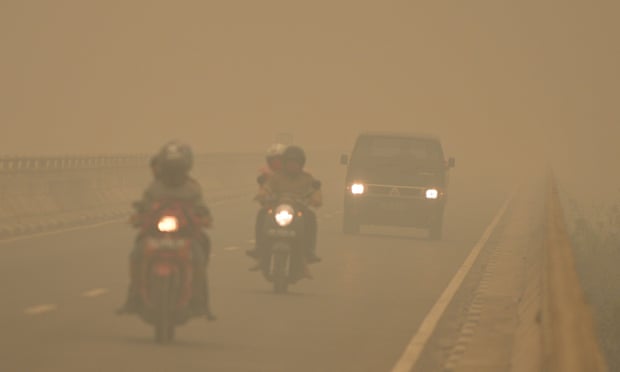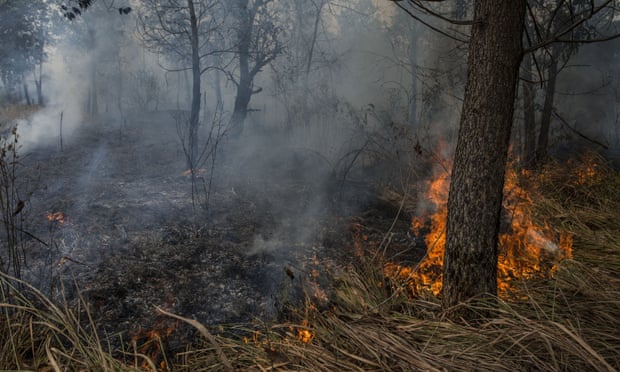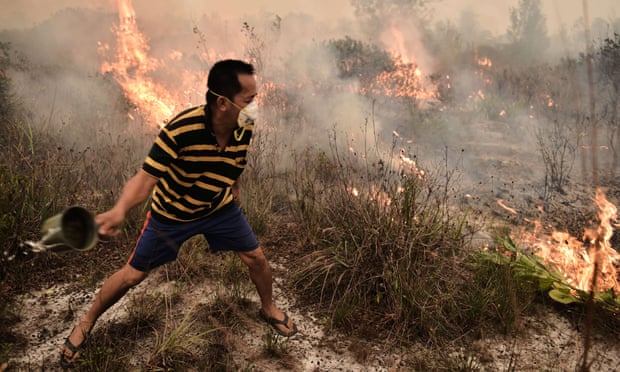~~~~~~~~~~~~~~~~~~~~~~~~~~~~~~~~~~~~~~
While the US president and other leftist leaders blame the West for climate change (they don't call it global warming anymore), countries in Asia are perpetrating ecological crimes against humanity.
More than 1.7 million hectares (4.2 million acres) of land has been burned and six provinces severely affected by the haze, according to Indonesia's forestry ministry
Fires deliberately set by villagers to clear land are raging across Indonesia, creating thick smog that's believed to be the caused of 500,000 respiratory infections. The government has been in readiness to evacuate victims from haze-affected provinces, while pollution caused by the fires has killed many and caused respiratory illnesses in half a million.
The conditions are so extreme that Sutopo Puro Nugroho, spokesperson for the Meteorology, Climatology and Geophysics Agency (BMKG) recently called the persistent haze a "crime against humanity," adding that 43 million people have been inhaling toxic fumes from the smoke for months.
Innocent animals are being victimized
A few days ago I posted an article on Indonesia deliberately setting forests on fire to clear land, and then attacking defenseless orangutans who try to flee to safety. It was the heartbreaking story of a starving mother orangutan with a baby reaching a village only to be stoned by villagers.
An endangered Borneo orangutan and its baby escaped from raging fires in Indonesia that destroyed their forest habitat - only to be attacked by angry villagers.
The malnourished mother and youngster, called Gito, were found distressed and clinging to one another as locals hurled rocks at them and tried to tie them up before they were saved by International Animal Rescue (IAC). Read more here
Indonesia's forest fires threaten a third of endangered orangutans. Fires have spread beyond plantations deep into primary forests and national parks, the last strongholds of the endangered apes.
But not much is being reported about Indonesia's ongoing practice of setting fire to the forests, with the resulting destruction of trees, animals' habitat and animals themselves, and the poisoning of the air with smoke that make people ill, not only in Indonesia but in many other parts of Southeast Asia.
Continue reading
People are fleeing the "haze". The term "haze" refers to the byproduct of destructive fires that have helped raze rain forest on the massive island of Sumatra, which is part of the Indonesian archipelago.
Desperate evacuees took to their motorbikes in a desperate attempt to escape the acrid haze and choking pollution caused by thousands of forest fires in Indonesia
There, a mix of industrial-scale and small-scale farmers are constantly setting fires to clear forested areas, and peaty wetlands, to plant palm oil or acacia tree plantations.
But the problem is these fires often burn out of control, torching neighbouring plots. And when these fires are set on Sumatra’s peat land – on which it is impossible to grow palm trees – the earth itself catches fire, burning underground, defying efforts to extinguish it and sending up huge plumes of choking smoke that drift across the region.
Helping hand: A volunteer firefighter attempts to dowse the flames after many of the fires were deliberately started by farmers using the slash-and-burn method to clear land
This monumental problem reaches well beyond the country’s borders: A professor at VU University Amsterdam estimates Indonesia’s fires this year have already surpassed the total greenhouse gas emissions of Germany and the burning season, lengthened by an El Nino, is far from over. But why do the fires keep happening?
In one of Sumatra's villages, inhabitants lay claim to hundreds of acres around their plots, which they said were given to the community in 1978 by the federal government as part of the country’s “transmigration” scheme to shift Javanese off Indonesia’s populous isle of Java into rural areas in Sumatra.
The land was then, apparently, sold to a company by the local government in Riau – where three consecutive governors have been arrested by the country’s Corruption Eradication Commission (KPK).
The role of corruption - In the capital of Jakarta, obvious corruption is hard enough to nail down and punish. But out here in the hinterland, even if satellite imagery can trace the origins of fires by the smoke, there is too often confusion as to who is responsible – whether it was a large company or small-holders; whether licences were overlapping, outdated or contested. And cash-strapped (or corrupt) local authorities are also slow to act. Despite some arrests, every year the fires burn on.
The government has deployed around 30 aircraft to fight the fires and for cloud seeding with 22,000 troops on the ground to combat the blazes
The Guardian's summary of the situation:
Where are the fires?
As satellite data of the fire hotspots shows, forest fires have affected the length and breadth of Indonesia. Among the worst hit areas are southern Kalimantan (Borneo) and western Sumatra.
The fires have been raging since July, with efforts to extinguish them hampered by seasonal dry conditions exacerbated by the El Nino effect. As well as Indonesia, the acrid haze from the fires is engulfing neighbouring Malaysia and Singapore and has reached as far as southern Thailand.
What is the damage?
The most obvious damage is to the forest where the fires are occurring. Indonesia’s tropical forests represent some of the most diverse habitats on the planet. The current fire outbreak adds to decades of existing deforestation by palm oil, timber and other agribusiness operators, further imperilling endangered species such as the orangutan.
The human cost is stark; 19 people have died and an estimated 500,000 cases of respiratory tract infections have been reported since the start of the fires. It’s estimated that the fires could cause more than 100,000 premature deaths in the region.
Financial damage to the region’s economy is still being counted, but the Indonesian government’s own estimates suggest it could be as high as $47bn, a huge blow to the country’s economy.
A World Bank study (pdf) on forest fires last year in Riau province estimated that they caused $935m of losses relating to lost agricultural productivity.

Commuters drive through thick haze in Tumbang Nusa, Central Kalimantan
What is causing the fires?
Forest fires have become a seasonal phenomenon in Indonesia. At the root of the problem is the practice of forest clearance known as slash and burn, where land is set on fire as a cheaper way to clear it for new planting.
Peat soil, which characterises much of the affected areas, is highly flammable, causing localised fires to spread and making them difficult to stop.
Who is responsible?
It’s a blame game, with everyone pointing the finger at someone else. Environmental group WWF Indonesia, which has been highlighting the problem of Indonesia’s recurrent fires for years, says that the fires are caused by the “collective negligence” of companies, smallholders and government (which isn’t investing sufficiently in preventative measures).
Many blame big business. According to a recent analysis of World Resources Institute data in September, more than one third (37%) of the fires in Sumatra are occurring on pulpwood concessions. A good proportion of the rest are on or near land used by palm oil producers.
“Many of these fires are a direct result of the industrial manipulation of the landscape for plantation development,” says Lindsey Allen, executive director of the conservation organisation Rainforest Action Network.
In September, the Indonesian police arrested seven executives in connection with the fires, including a senior executive from Bumi Mekar Hijau (BMH), which supplied Jakarta-based paper giant Asia Pulp and Paper (APP).
Others look away from the big corporations for blame. According to Henry Purnomo, professor at Indonesia’s Bogor Agricultural University and a scientist at research group CIFOR, there are two culprits: poor small-scale farmers looking to expand their farmland, and rogue operators intent on illegally clearing forests for land acquisition.
Global corporations operating in the area also blame smallholders and under-the-radar companies.

Fire burns in Palembang, South Sumatra, Indonesia. Air pollution caused by the illegal burning of forests is an annual problem.
The Roundtable on Sustainable Palm Oil, which counts many big palm oil businesses as members, has consistently said that the instances of fire on certified palm plantations in the affected region (which number 137) measure in single digits.
Brendan May, chairman of sustainability advisory firm Robertsbridge (which has APP as a client), argues that it’s “not in companies’ best interest” to set fire to their own assets – an argument some campaign groups dispute.

A villager tries to extinguish a peatland fire on the outskirts of Palangkaraya city, Central Kalimantan.
What needs to be done?
Ending the practice of slash and burn is vital. Companies – big and small - must be held to account, before the law and the market, if found culpable.
Smallholders need assistance and incentives to pursue alternative, less harmful practices of forest management. Forest-dwelling communities often lack the skills and training, according to a recent CIFOR report.
Meanwhile processors and buyers often fail to pay smallholders a fair price, something the signatories to the Sustainable Palm Oil Manifesto (which claims to go beyond RSPO certification standards) have pledged to correct.
Many big firms, such as palm producer Wilmar and timber giant APP, have signed zero-deforestation pledges in recent years. But the real test comes in pushing their commitments beyond the boundary fences of their plantations and down into their supply chains, where smaller firms operate with less public scrutiny.
Many are calling on the Indonesian government to step up. WWF-Indonesia’s deputy director, Irwan Gunawan, says the government action lacks clout and “has not yet resulted in deterrent effect to prevent any recurrence”.
Removing the culture of political patronage that protects private companies in Indonesia is essential, says Purnomo. A budgetary rethink is also required. At present, the ratio of public spending on fire suppression versus prevention is around 80:20, Purnomo says.
Another major contribution to reducing future fires would be an up-to-date online, searchable land registry. Land tenure in Indonesia is often unknown or disputed, making it difficult to establish where responsibility lies.
Coupling such a database with digital mapping technologies such as WRI’s Global Forest Watch could make identifying the culprits a whole lot easier. One Map, a government-backed project to develop such a spatial mapping solution, is currently under development.
References
http://www.theguardian.com/world/2015/oct/26/indonesias-fires-crime-against-humanity-hundreds-of-thousands-suffer
http://www.theweathernetwork.com/news/articles/climate-disaster-indonesia-fires-a-crime-against-humanity/59052/
Indonesia - the flight from air pollution
http://www.dailymail.co.uk/news/article-3287801/Indonesia-shrouded-acrid-haze-forest-fire-prepared-evacuate-thousands-path-choking-pollution.html
Why Indonesia's fires burn out of control
http://www.theglobeandmail.com/news/world/why-indonesias-fires-rage-out-of-control/article26879435/
Indonesia's forest fires - What you need to know
http://www.theguardian.com/sustainable-business/2015/nov/11/indonesia-forest-fires-explained-haze-palm-oil-timber-burning
Forest fires choke much of Southeast Asia
http://www.theguardian.com/environment/2015/oct/05/forest-fires-in-indonesia-choke-much-of-south-east-asia
~~~~~~~~~~~~~~~~~~~~~
- That country sets fire to forests to clear land for palm oil exports
- In INDONESIA they also have the tradition of skinning and BLOWTORCHING DOGS ALIVE to be eaten as food
Read more
http://ottersandsciencenews.blogspot.ca/2015/11/orangutan-mother-and-baby-escape-forest.html
~~~~~~~~~~~~~~~~~~~~~

Indonesia's forest fires threaten a third of endangered orangutans
Fires have spread beyond plantations deep into primary forests and national parks, the last strongholds of the endangered apes
http://www.theguardian.com/environment/2015/oct/26/indonesias-forest-fires-threaten-a-third-of-worlds-wild-orangutans
***************************************************************
No comments:
Post a Comment
Thank you for visiting my blog. Your comments are always appreciated, but please do not include links.